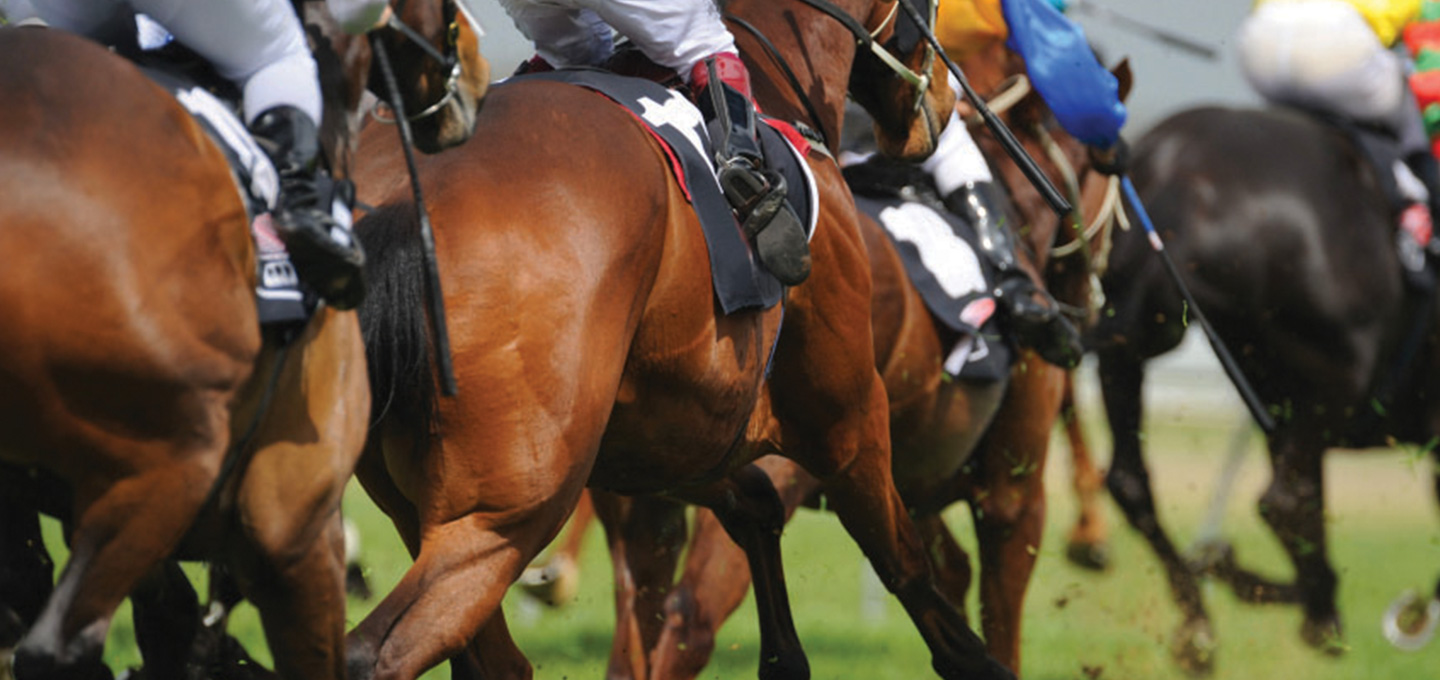Before addressing the horse nutrition, it is first necessary to focus on the functioning of its organism. The understanding of its digestive peculiarities, the growth of the foal or the muscular physiology of the horse at work is an essential prerequisite for the development of a balanced diet.
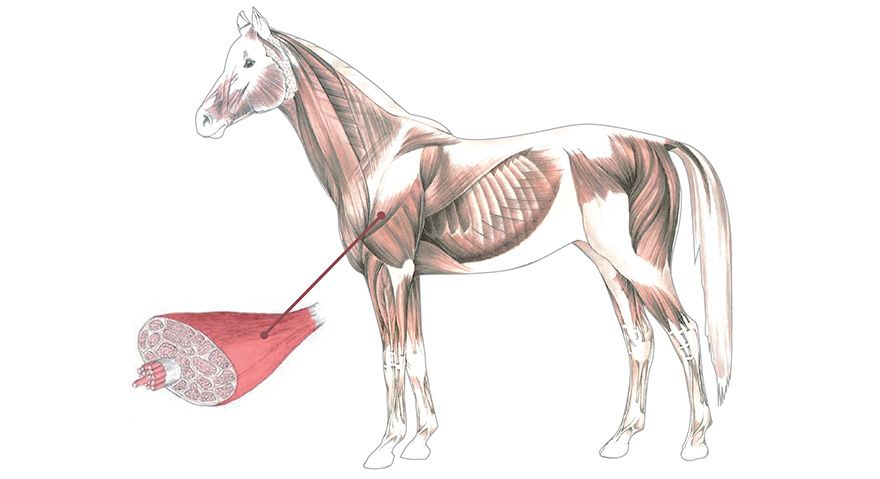
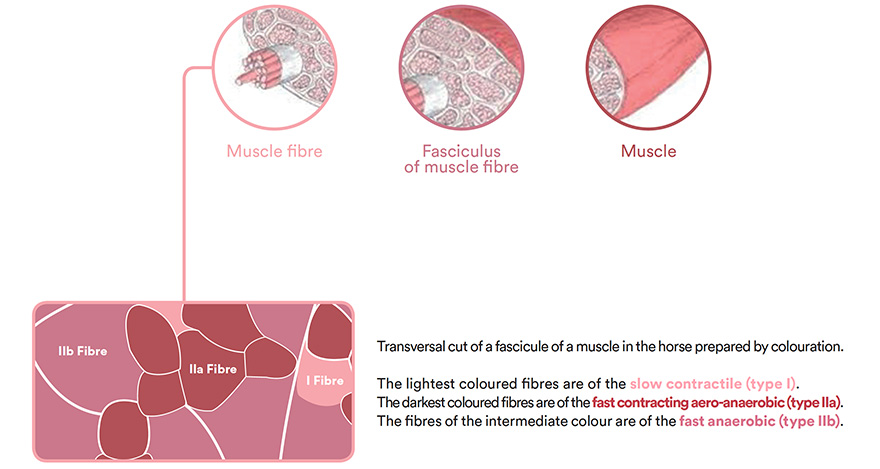
Detailed muscle organisation
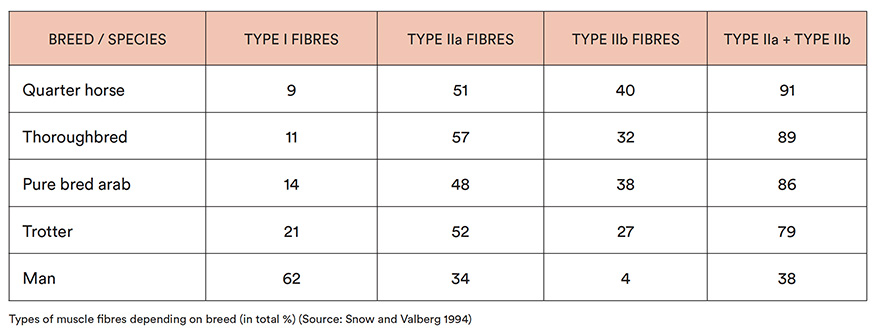
Type I muscle fibres
These fibres have great ability to use oxygen (aerobic) and have a good energetic yield : The combustion of substrate (lipids) is complete, without waste.
The preferred use of lipids spares glycogen and bestows an aptitude for prolonged effort. These fibres do not tire easily but the speed at which they contract is slow which limits the intensity of work produced. Therefore they are used in priority at walk and are suited for endurance (long, slow) efforts.
Type IIa muscle fibres
Intermediary they contract rapidly but are fairly economic in glycogen (good aerobic metabolism). The burning of carbohydrates is more or less complete without accumulation of lactic acid.
The energetic yield is excellent (moderate heat loss). They are suited to intense prolonged efforts such as long sprints.
These fibres are responsible for the maintenance of speed (staying power) and are of primordial importance to thoroughbred and to French trotter running capacities over classic distances of approximately 2,500 metres.
Type IIb muscle fibres
A large quantity of glycogen is burnt but with more or less total absence of oxygen (anaerobic).
Thus combustion is incomplete and results in the production of lactic acid which accumulates in the muscle cells.
The energetic yield is therefore mediocre (important thermal losses).
However given that these fibres are the largest in size and their contractile speed are very fast, they are ideally suited to efforts requiring power and short sprints. These fibres are largely responsible for innate speed and are determining factor in the quarter horse, racing over 400 metres.

Work of muscles depending on the pace
Walkings
- The muscles contract very slowly. The type I fibres are recruited in priority and uniquely generate energy aerobically.
- At this speed the muscles burn mainly fats. The reserves are plentiful, their mobilisation and metabolism are fairly fast and are sufficient to regenerate energy used while walking.
In practive
Provide horses training at fast walking pace with lipids (endurance horses).
Fast walking is useful when reintroducing overweight horse into work.
It is of equally benefit to the osteo-articular system, unsolicited for a certain period.
At trot and canter
- Type I fibres alone cannot contract fast enough to propel the horse, so type IIA fibres are recruited. They are in majority aerobic but use a mix of glycogen and fats to generate energy
- Glycogen (or glucose): provides aerobically produced energy at twice the speed of lipids. It is used in preference when speed is increased.
In practice
Provide carbohydrates in the ration, in particular in the form of starch:
"Effectively, this is a choice energy source for the synthesis of glycogen as its digestion leads to an increase in the glycaemia and the insulinaemia, two of the most important parameters implied in the synthesis of glycogen" (Pagan and al., 1998).
A part of the ration should provide lipids; they will be used principally the days of quiet exercise (slow and moderate speed). They allow a partial sparing of muscle glycogen reserves for those days of intense exercise.
Very fast trot or gallop (sprinting)
- Type IIB fibres are also recruited. At this speed, energy is not uniquely produced aerobically. Only the important combustion of glycogen without oxygen (anaerobic glycolysis) allows the generation of sufficient energy to maintain this speed.
- Disadvantage: The production and accumulation of lactic acid drops the intramuscular PH which will be responsible for the appearance of muscular fatigue.
In practice
Importance of starch being present in the ration as it represents a choice energy source for the synthesis of glycogen.
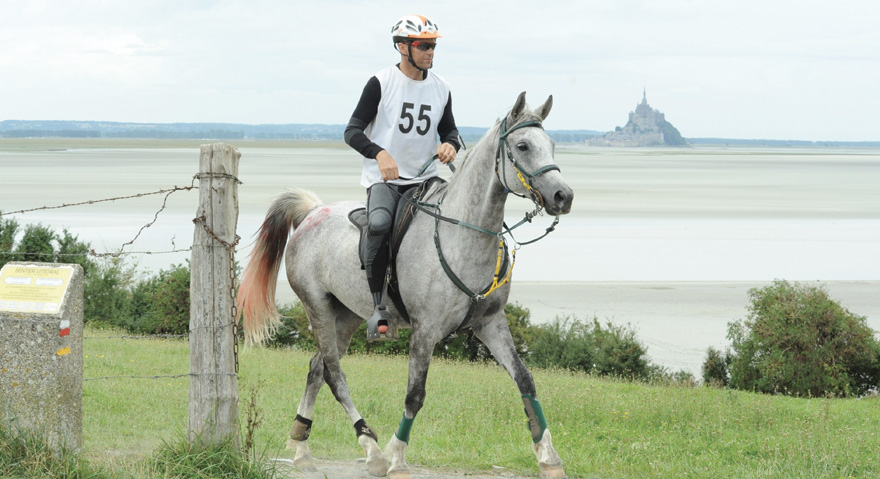
Work of muscles according to the discipline
Concept of anaerobic threshold
Endurance effort (12-19 km /h)
Low use of muscular glycogen = the rest of required energy is produced by fat oxidation.
Faster effort
When speed increases, the use of muscular glycogen equally increases.
From a certain speed (see the curve) the majority of energy production can no longer be assured aerobically: the horse reaches his « anaerobic threshold » or « fatigue threshold ».
From this point onwards an important place is held by anaerobically produced energy, from where, there is an exponential increase in the use of glycogen and an accumulation of lactic acid. The horse enters into the « red zone ».
Following this, muscle tiredness is rapidly felt: the effort cannot be sustained for a long period.
The brutal increase in the consumption of glycogen is caused by the recruitment and use of an anaerobic metabolism which has an energetic yield 12 times inferior of that of the aerobic metabolism. The result is the production of a waste product responsible for the appearance of muscular fatigue: lactic acid.
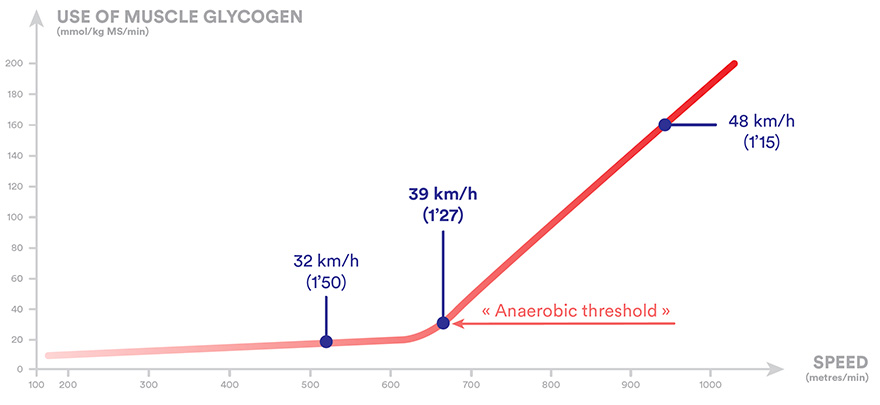
Curve (Pagan, 1998)
This shows the amount of muscular glycogen used per minute according to the speed of the horse. This data was collected after different races (averages).
Note that providing the horse stays below 39km/h (1min27 sec per km) very little glycogen is used. However, as speed increases the horse approaches his « anaerobic threshold ». From this point onwards glycogen is consumed in an exponential way.
Racehorses
- Anaerobic threshold:
- Unique to each horse: the point at which it reaches the « red zone ».
- The later the anaerobic threshold appears during effort, the better the horse.
- The appearance of tiredness is caused by the accumulation of lactic acid
- The aim of training is to delay to a maximum this threshold. To do this we must trigger a conversion of type IIB fibres into IIA fibres as shown by Essen and Lindholm (see the table)

Table (Essen et Lindholm, 1985)
The authors have shown that the performance of American trotters running mainly over 1,600 meters is correlated to the distribution of type II muscle fibres.
In effect, the best horses in the study had a greater proportion of type IIa muscle fibres.
- The important principals of training are the following:
- Work on stamina: long and slow exercise that increase the cardio-vascular and bio-mechanical effectiveness.
- Increase the aerobic capacity: work at slower speeds but approaching the anaerobic threshold.
- Reinforce the aerobic power (stamina and resistance): work around the anaerobic threshold.
- Stimulate the anaerobic power and the tolerance to lactic acid: repeated short exercises (interval training) which more or less exceed the anaerobic threshold.
Endurance horses
- Movement is nearly always maintained by aerobically produced. energy. Sometimes, energy requirements can exceed the capacity for aerobically produced energy.
Exemple: slopes or accelerations over longer or shorter distances. - The anaerobic threshold has therefore not the same importance as in the racehorse.
- The appearance of tiredness is very often the consequence of an exhaustion of the glycogenic reserves, thus the importance of providing enough starch in the ration and the use of lipids will permit a preservation of glycogen reserves.
- Principal objectives of training:
- Increase efficiency of aerobic energy production notably by increasing the relative part of type I fibres by long, slow work sessions (fast walking, trotting).
- Improve bone solidity, cardio-respiratory and bio-mechanical effectiveness faster work sessions (canter) and/or on slopes.




